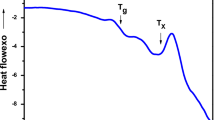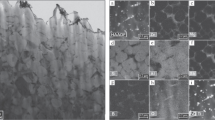Abstract
Four laser glasses with high emission cross sections are experimentally obtained. The laser performance parameters are determined from the spectroscopic parameters of these glasses and compared with those of developing laser glasses abroad. It is shown that Yb3+-doped telluorogermanate, Yb3+-doped niobosilicate glasses have the highest emission cross section and gain coefficient, the smallest minimum pumping intensity and saturation pumping intensity, and the lowest minimum fraction of excited ions. Yb3+-doped borate glass follows just behind them. These glasses have some spectroscopic advantages over laser glasses developed recently elsewhere. Yb3+-doped phosphate glass is comparable to phosphate laser glass which had high emission cross section and was developed recently by HOYA Corporation in Japan. The domestic glasses with optimum spectroscopic properties may be promising candidates for applications in high-average power and high-peak power solid state lasers, especially laser for the next generation laser nuclear fusion facility.
Similar content being viewed by others
References
Krupe, W. F., Dependence of the4F3/2−4F11/2 induced-emission cross section for Nd3+ on glass composition,IEEE J. Quantum Electron., 1974, 80: 450.
McCumber, D. E., Einstein relationship connecting broadband emission and absorption spectra,Physical Review, 1964, 136 (4A): 954.
Peng, B., Izumitani, T., Next generation laser glass for nuclear fusion,The Review of Laser Engineering, 1993, 21(12): 1234.
Zou Xuelu, Toratani, H., Evaluation of spectroscopic properties of Yb3+-doped glasses,Physical Review B, 1995, 52(22): 15889.
Koch, R., Griebner, U., Schonnagel, H. et al., Efficiency room temperature CW Yb3+: Glass laser pumped by a 946 nm Nd: YAG Laser,Optical Communication, 1997, 134(1–6): 175.
Petrov, V., Griebner, U., Ehrt, D. et al., Femtosecond self mode locking of Yb: fluoride phosphate glass laser,Optics Letters, 1997, 22(6): 19.
Jiang Chun, Zhang Junzhou, Zhuo Dunshui Investigation of removal of OH group in BaO−P2O5 and R2O−BaO−P2O5 laser glass,Chinese Laser (in Chinese), 1996, 23(2): 182.
Jiang Chun, Zhuo Dunshui Zhang Junzhou, Effect of process atmospheres on removal efficient of OH group in BaO−P2O5 and R2O−BaO−P2O5 laser glasses,Laser & Optronics Progress (in Chinese), 1996, (7): 98.
Jiang Chun, Zhang Junzhou, Zhuo Dunshui, Effect of process atmospheres on formation and elimination of platinum inclusions in BaO−P2P5 and R2O−BaO−P2O5 laser glasses,Journal of Laser & Optronics Progress (in Chinese), 1996, (7): 222.
Jiang Chun, Zhang Junzhou, Zhuo Dunshui, Investigation of relationship between platinum inclusion density and oxide-reduction equilibrium in phosphate laser glasses,Chinese Laser (in Chinese), 1996, A23(11,12): 1047.
Author information
Authors and Affiliations
Additional information
Project supported by the National Natural Science Foundation of China (Grant No. 69578026)
Rights and permissions
About this article
Cite this article
Jiang, C., Zhang, J., Deng, P. et al. Optimization of spectroscopic properties of ytterbium-doped laser glasses. Sci. China Ser. E-Technol. Sci. 42, 616–622 (1999). https://doi.org/10.1007/BF02916998
Received:
Issue Date:
DOI: https://doi.org/10.1007/BF02916998




